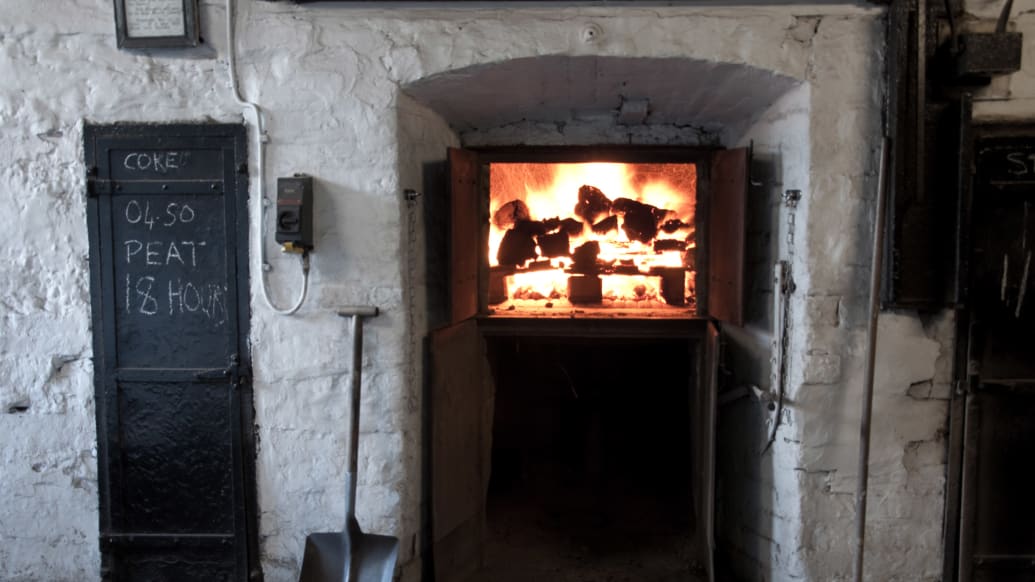American craft spirits brands have recently taken a cue from ’cue—barbecue, that is. People love the smoky flavor of meats cooked slow and low over a carefully-tended, smoldering fire and distillers have begun to add that complex essence to their liquor.
Hillrock Estate Distillery, in New York’s Hudson Valley, for one, smokes the barley it grows on its land over peat fires. Corsair Distillery in Nashville goes even further with its Triple Smoke whiskey, using grains smoked over peat, as well as beech and cherry wood fires. The smoke adds flavor, aroma and a richness and depth to the whiskey. (There is even a new gin made with applewood-smoked juniper.)
But this technique, of course, is old hat to the world’s most famous whisky makers in Scotland. Scotch is often associated with the smoky tang of peat and is described using words like iodine, bonfire and tar and diesel, or the more abstract Band-Aid. Peat is a polarizing flavor. Those who enjoy it have an insatiable desire for it, seeking out whiskies with ominous names like Big Peat, Peat Monster and Supernova.
But despite the ingredient’s fame, just about anytime I conduct a single-malt tasting for the public, a brave soul works up the nerve to ask me, “So…what is peat?”
It is a simple question with an equally simple, if a bit lengthy, answer. Peat starts as peat moss, the gardening compost found in bags at your local hardware store. The moss grows in bogs and wetlands. As it grows, year after year, the weight of new growth gradually presses older plants down into the water and mud.
But because this plant matter is under water, away from air, it does not rot. It compacts and becomes a solid, dark brown mass. The process is actually the earliest stage of coal production. And, like coal, carbon-rich peat can be burned for fuel. About two percent of the world’s land surface is peat, and it has been a traditional source of fuel for much of human existence.
Scotch whisky uses peat on a small, hand-labor scale. Peat cutters work a bog with hand tools, cutting two-foot-long strips of peat—called turves—and turning them out on dry ground to drain. The dried turves are then sent to the malt makers.

The first step in making malt for whisky is to wet barley so it begins to germinate and its stores of starch turn into readily fermentable sugar. The final step is to heat up the barley, which prevents the grain from sprouting and growing into plants.
Today that is usually done in giant natural gas—fired ovens, the advantage being that the method doesn’t affect the flavor of the grain, which ultimately produces a fruitier, lighter whisky. But when you’re making a smoky whisky, go old school: reach for the turves. In a peat-fired malt kiln, the malt is spread out on a perforated floor directly above a chimney, allowing billows of the pungent smoke rising up from the peat fire to flavor the grain.
The smoke is more than distinctive, it’s regional. Echoing the wine world’s so-called terroir—the effect of place on the flavor of a wine—peat is different everywhere it is cut. Plants, soil, water source and temperature can all differ, and that makes for clear variations in smoke flavor. Chemical analysis reveals that these differences are indeed real and measurable. And while the human nose has known that for years, it is nice to have scientific authentication.

Most Scotch distillers buy their smoked malt; the big Port Ellen malting, on the island of Islay, supply many of them. But some still smoke their own grains in small in-house facilities. On the island of Orkney, I followed a load of peat from Hobbister Moor, to the nearby fireroom at Highland Park’s distillery. The cutting face at Hobbister is about six-feet deep, revealing about 5,000 years’ worth of peat. All the way down, where the peat was quite black and solidly compacted, I could still see individual plant stems dating back to 3,000 B.C.
Once the peat was dried and taken to the distillery, I got a chance to shovel some into the fire. But I screwed up: things went up in flames. “Don’t waste it,” I was told. I quickly shoveled more in on top of the hot spot and a rewarding cloud of reek rose. In 15 years, you can enjoy a bottle of the final product—and thank me.

